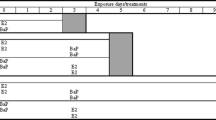Abstract
Induction of ethoxyresorufin-O-deethylase (EROD) activity and porphyrin accumulation shows different structure-activity relationships for different polychlorinated biphenyls (PCBs) and 2,3,7,8-tetrachlorodibenzo-p-dioxin (TCDD). Interactions between the two responses can strongly influence the induction and activity of EROD. The results support the conclusion that there are nonadditive interactions between nondioxin-like PCBs and dioxin-like compounds. The interaction between EROD activity and the porphyrin biosynthesis makes the prerequisite of additivity in the toxic equivalency factor concept for environmental mixtures highly spurious. Inhibition of EROD activity caused by non-dioxin like compounds could have a significant impact on the value of EROD activity as a biomarker in the present methods of risk assessment for these compounds.
Similar content being viewed by others
References
S. Safe: Polychlorinated Biphenyls (PCBs): Environmental Impact, Biochemical and Toxic Responses, and Implications for Risk Assessment. C.R.C. Crit. Rev. Toxicol. 24, 87 (1994)
S. Safe: Polychlorinated Biphenyls (PCBs), Dibenzo-p-dioxins (PCDDs), Dibenzofurans (PCDFs), and Related Compounds: Environmental and Mechanistic Considerations Which Support the Development of Toxic Equivalency Factors (TEFs). C.R.C. Crit. Rev. Toxicol. 21, 51 (1990)
NATO/CCMS, North Atlantic Treaty Organization/ Committee on the Challenges of Modern Society. International toxicity equivalency factor method of risk assessment for complex mixtures of dioxins and related compounds, 1988, Report no. 176
U. G. Ahlborg;G. C. Becking;L. S. Birnbaum;A. Brouwer;H. J. G. M. Derks;M. Feeley;G. Golor;A. Hanberg;J. C. Larsen;A. K. D. Liem;S. H. Safe;C. Schlatter;F. Waern;M. Younes;E. Yrjänekikki: Toxic Equivalency Factors for Dioxin-like PCBs. Chemosphere, 28, 1049 (1994)
A. T. C. Bosveld;J. Gradener;A. J. Murk;A. Brouwer;M. van Kampen;E. H. G. Evers;M. van den Berg: Effects of PCBs, PCDDs, and PCDFs on Common Tern (Sterna Hirundo), breeding in estuarine and coastal colonies in the Netherlands and Belgium. Environ. Toxicol. Chem. 14, 99 (1995)
D. E. Tillitt;G. T. Ankley;D. A. Verbrugge;J. P. Giesy;J. P. Ludwig;T. J. Kubiak: H4IIE Rat Hepatoma Cell Bioassay-Derived 2,3,7,8 — Tetrachlorodibenzo-p-dioxin Equivalents in Colonial Fish-Eating Waterbird Eggs from the Great Lakes. Arch. Environ. Contam. Toxicol. 21, 91 (1991)
M. Van Den Berg;B. L. H. J. Craane;T. Sinnige;S. Van Mourik;S. Dirksen;T. Boudewijn;M. Van Der Gaag;I. J. Lutkas-Schipholt;A. Brouwer: Biochemical and Toxic Effects of Polychlorinated Biphenyls (PCBs), Dibenzo-p-dioxins (PCDDs) and Dibenzofurans (PCDFs) in the Cormorant (Phalacrocorax Carbo) After In Ovo Exposure. Environ. Toxicol. Chem. 5, 803 (1994)
P. R. Sinclair;W. J. Bement;H. J. Bonkovsky;J. F. Sinclair: Inhibition of Uroporphyrinogen Decarboxylase by Halogenated Biphenyls in Chick Hepatocyte Cultures. Biochem J. 222, 737 (1984)
R. W. Lambrecht;P. R. Sinclair;N. Gorman;J. F. Sinclair: Uroporphyrinogen Oxidation Catalyzed by Reconsituted Cytochrome P4501A2. Arch. BioChem. BioPhys. 294, 504 (1992)
A. G. Smith;F. de Matteis: Oxidative Injury Mediated by the Hepatic Cytochrome P-450 System in Conjunction with Cellular Iron. Effects on the Pathway of Haem Biosynthesis. Xenobiotica 20, 865 (1990)
P. R. Sinclair;W. J. Bement;R. W. Lambrecht;N. Gorman;J. F. Sinclair: Chlorinated Biphenyls Induce Cytochrome P4501A2 and Uroporphyrin Accumulation in Cultures of Mouse Hepatocytes. Arch. Biochem. Biophys. 281, 225 (1990)
A. B. Rifkind;A. Kanetoshi;J. Orlinick;J. H. Capdevila;C. Lee: Purification and Biochemical Characterization of Two Major Cytochrome P-450 Isoforms Induced by 2,3,7,8-Tetrachlorodibenzo-p-dioxin in Chick Embryo Liver. J. Biol. Chem. 269, 3387 (1994)
M. D. Erikson: Analytical Chemistry of PCBs, Butterworth Publishers, Stoneham, USA, 1986, p. 6
M. Tysklind; P. Andersson; P. Haglund; B. van Bavel; C. Rappe: Selection of Polychlorinated Biphenyls for Use in Quantitative Structure-Activity Modelling. In press, SAR & QSAR Environ. Res.
S. W. Kennedy;A. Lorenzen;C. A. James;B. T. Cllins: Ethoxyresorufin-O — deethylase and Porphyrin Analysis in Chicken Embryo Hepatocytes with a Fluorescence Multiwell Plate Reader. Anal. Biochem. 211, 102 (1993)
A. Lorenzen;S. W. Kennedy: A Fluorescence-Based Protein Assay for Use with a Microplate Reader. Anal. Biochem. 214, 507 (1993)
S. Sano;S. Kawanishi;Y. Seki: Toxicity of Polychlorinated Biphenyls with Special Reference to Porphyrin Metabolism. Environ. Health Perspect. 59, 137 (1985)
L. E. Rodman;S. I. Shedlofsky;A. T. Swim;L. W. Robertson: Effects of Polychlorinated Biphenyls on Cytochrome P450 Induction in the Chick Embryo Hepatocyte Culture. Arch. Biochem. Biophys. 275, 252 (1989)
M. H. Hahn;T. M. Lamb;M. E. Schultz;R. M. Smolowitz;J. J. Stegeman: Cytochrome P4501A Induction and Inhibition by 3,3’,4,4’-Tetrachloro-biphenyl in an Ah Receptor-Containing Fish Hepatoma Cell Line (PLHC-1). Aqua. Toxicol. 26, 185 (1993)
C. Yao;B. Panigrahy;S. Safe: Utilization of Cultured Chick Embryo Hepatocytes as In Vitro Bioassays for Polychlorinated Biphenyls (PCBs): Quantitative Structure-Activity Relationships. Chemosphere 21, 1007 (1990)
J. W. Gooch;A. A. Elskus;P. J. Kloepper-Sams;M. E. Hahn;J. J. Stegeman: Effects ofortho- and Non-ortho Substituted Polychlorinated Biphenyls on the Hepatic Monooxygenase System in Scup (Stenotomus chrysops). Toxicol. Appl. Pharmacol. 98, 422 (1989)
A.T.C. Bosveld;E. Verhallen;W. Seinen;M. van den Berg: Mixture Interactions in theIn Vitro CYP1A1 Induction Bioassay Using Chicken Embryo Hepatocytes. In:L. Birnbaum, R. Clement, M. Fingerhut, F. Matsumura, S. Ramamoorthy, L. Robertson andS. Safe, Organohalogen Compounds, Vol.25, Edmonton, Canada, 1995, p. 309.
A.P.J.M. Van Birgelen;J. Van Der Kolk;K. M. Fase;I. Bol;H. Poiger;A. Brouwer;M. Van Den Berg: Toxic Potency of 3,3’,4,4’,5-Pentachlorobiphenyl Relative to and in Combination with 2,3,7,8-Tetrachlorodibenzo-p-dioxin in a Subchronic Feeding Study in the Rat. Toxicol. Appl. Pharmacol. 127, 209 (1994)
L. Asplund;B. Jansson;C. De Wit;S. Bergek;M. Hjelt;C. Rappe;T. Odsjö;M. Olsson: Polychlorinated Dibenzo-pdioxins (PCDD) and Dibenzofurans (PCDF) Compared to Other Organohalogen Pollutants in Biological Samples from Swedish Ecosystems. In:O. Hutzinger andH. Fiedler, Organohalogen Compounds, Vol. 1, Eco-informa Press, Bayreuth, FRG, 1990, p. 405
Author information
Authors and Affiliations
Rights and permissions
About this article
Cite this article
Tysklind, M., Bosveld, A.B.T.C., Andersson, P. et al. Inhibition of ethoxyresorufin-O-deethylase (EROD) activity in mixtures of 2,3,7,8-tetrachlorodibenzo-p-dioxin and polychlorinated biphenyls. Environ. Sci. & Pollut. Res. 2, 211–216 (1995). https://doi.org/10.1007/BF02986768
Received:
Accepted:
Issue Date:
DOI: https://doi.org/10.1007/BF02986768




